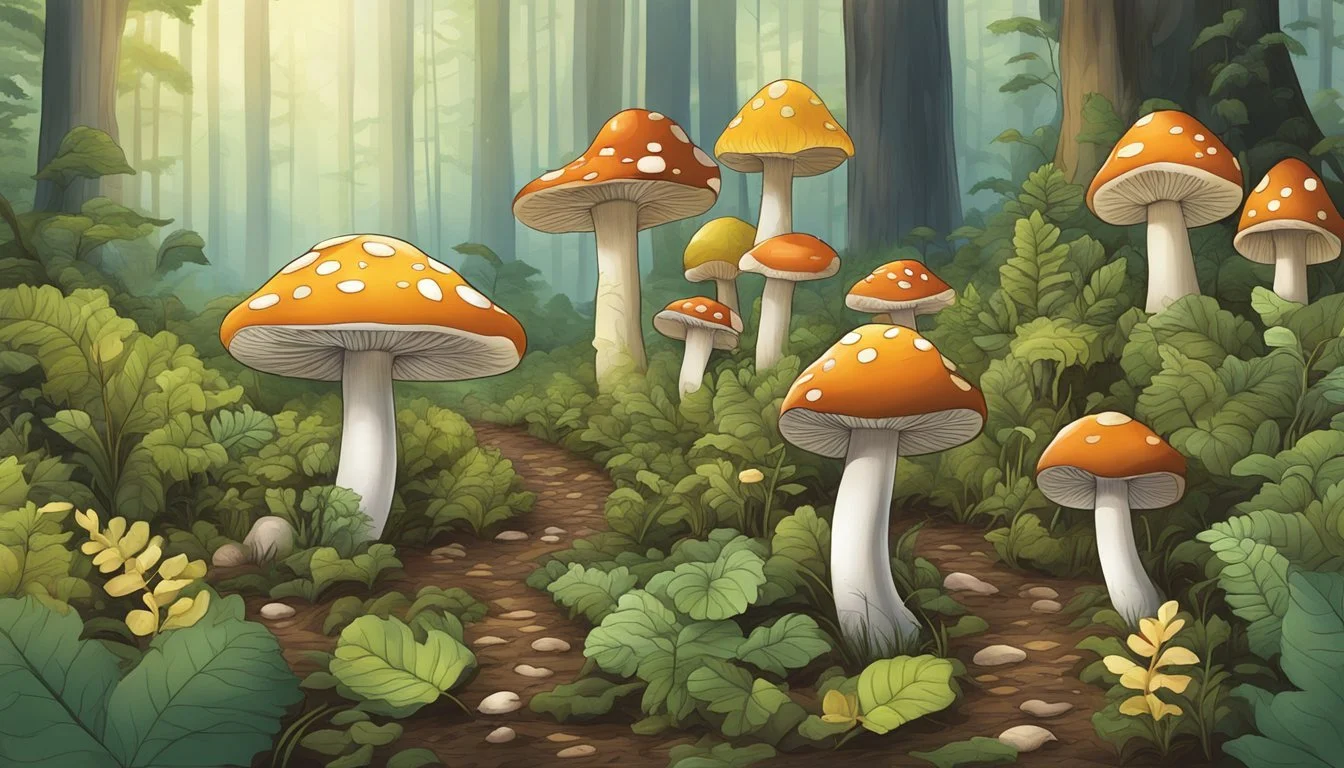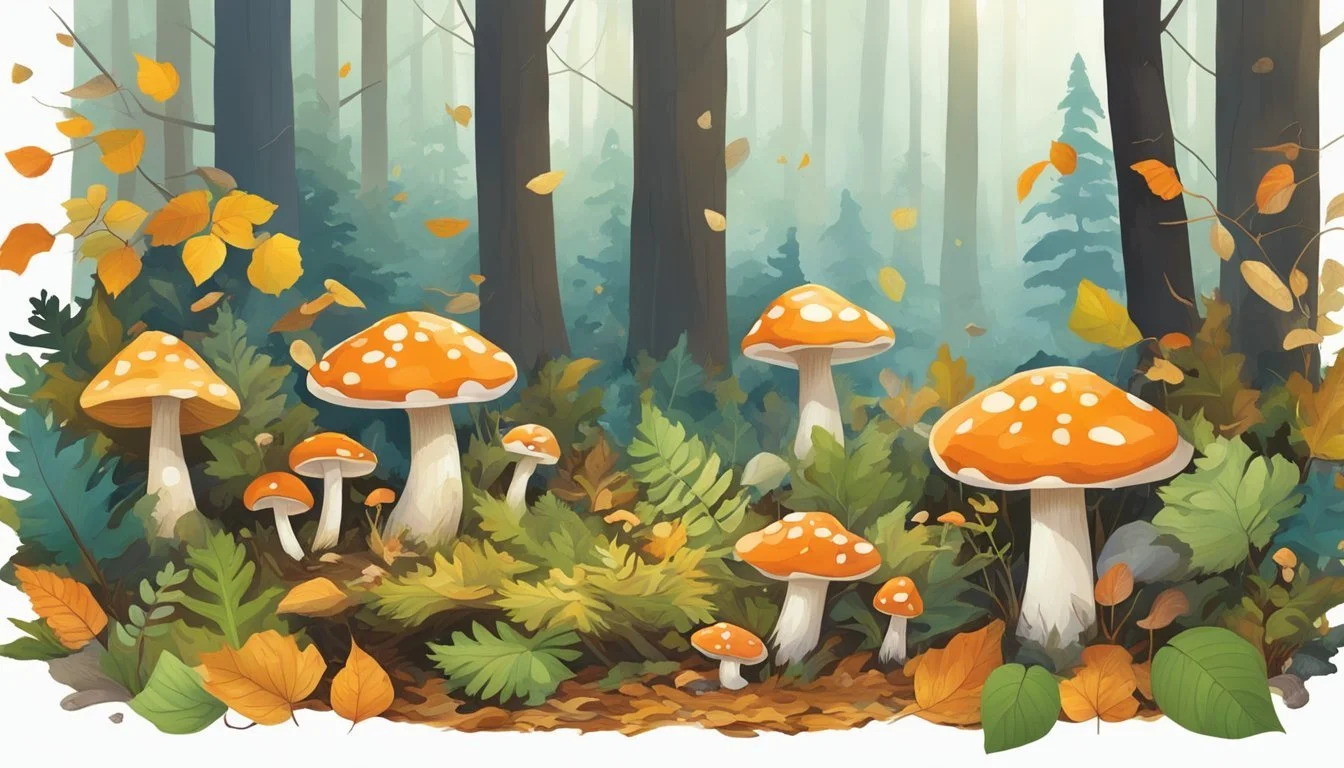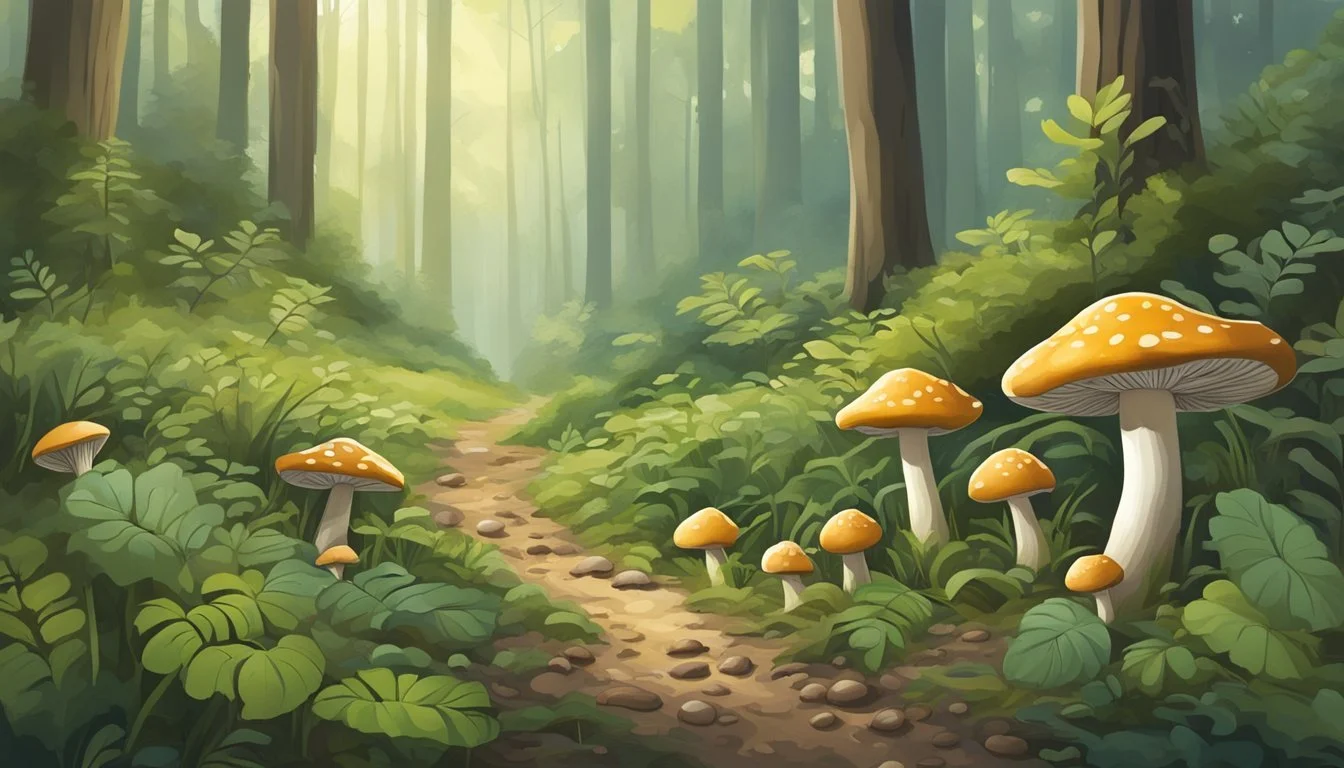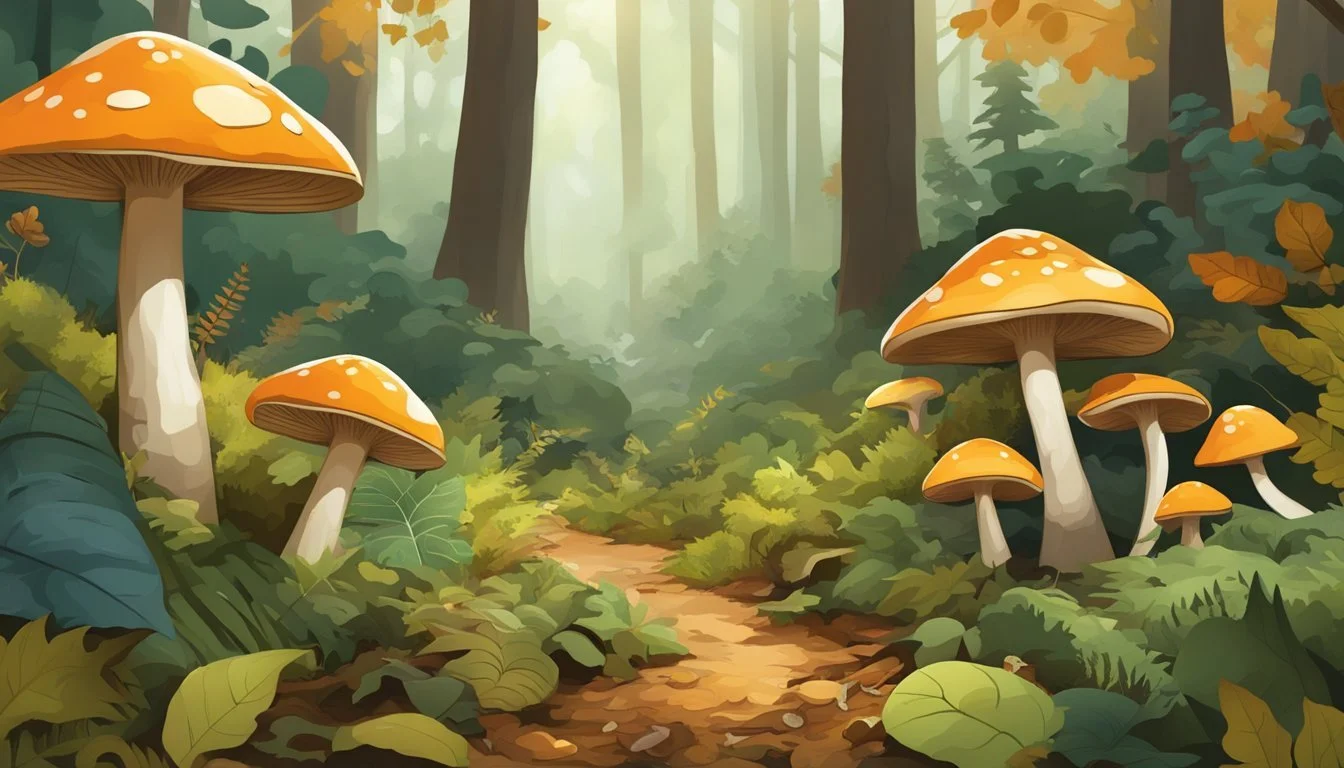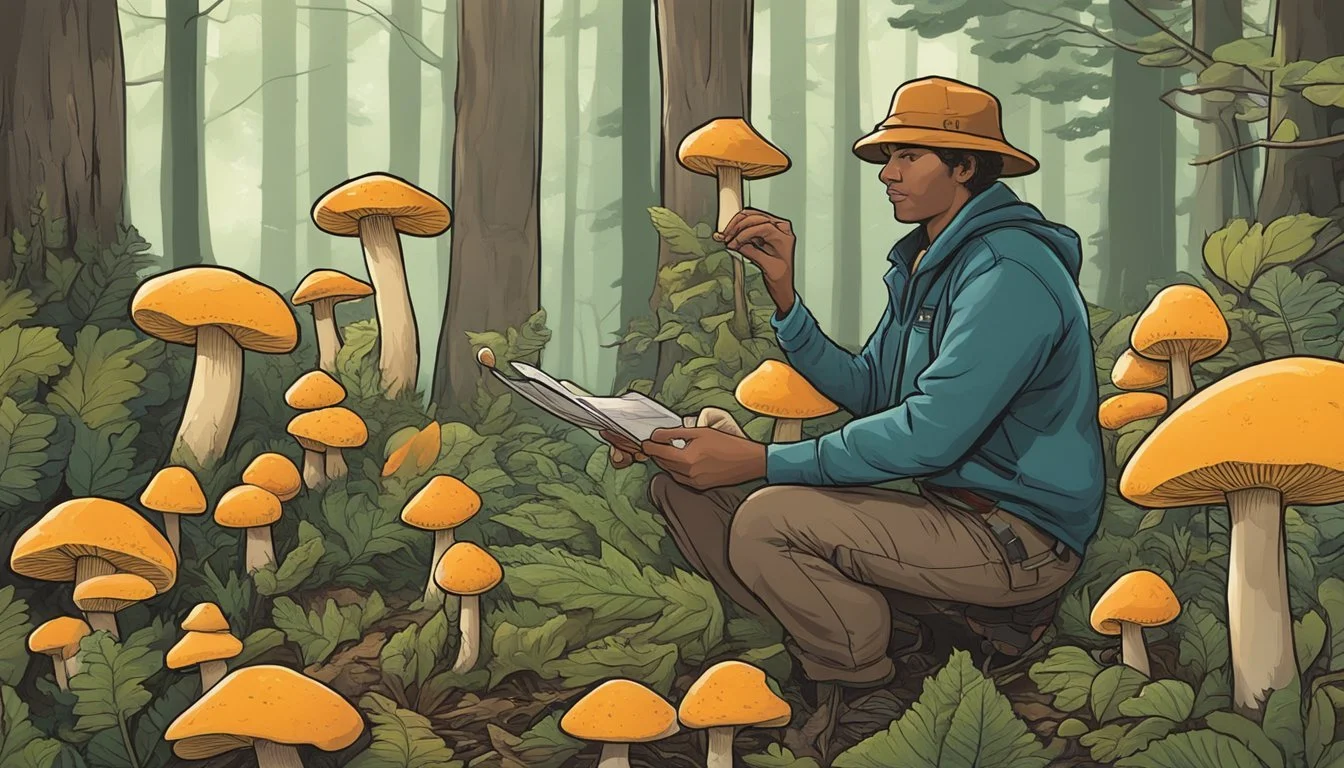Mushroom Hunting Illinois
A Guide to Seasonal Foraging Hotspots
This Article is Part of Our Guide on Mushroom Hunting for All 50 States
Mushroom hunting in Illinois offers foragers a rewarding experience as they explore the state's diverse woodlands. With a variety of edible mushrooms (What wine goes well with mushrooms?) growing in abundance, particularly in central Illinois, enthusiasts can seek out species such as the sought-after morel mushrooms, identifiable by their unique honeycomb-like appearance. Mushroom season peaks after April showers, when the conditions are prime for these fungal treasures to emerge.
Illinois' woodlands and forests are home to a wide range of mushrooms, beyond the prized morel. From the Turkey-tail Mushroom with its distinct multicolored fan-shaped form to the Chicken of the Woods known for its bright orange hues and meaty texture, the state presents a vast array of specimens. Foragers must always prioritize safety by accurately identifying any mushrooms they intend to consume and being aware of the proper foraging regulations set by local authorities.
While morel mushrooms typically take center stage during their brief season through the middle of May, other species such as the Oyster Mushroom and Honey Mushroom grow in various parts of the state, and their seasons extend beyond the fleeting weeks of the morel. These mushrooms are not only an integral part of the ecosystem but also a culinary delight for those who manage to find them. Mushroom hunters in Illinois look forward to the thrill of the search and the pleasure of a successful harvest.
Foraging for More Than Just Mushrooms in Illinois
Illinois' diverse landscapes, from the Shawnee National Forest to the Prairie State Park, offer a surprising array of wild edibles for the adventurous forager. While mushrooms are a sought-after find, the Prairie State's rich ecosystems provide a bounty of wild fruits, nuts, greens, and roots. Discover the unique flavors of the Midwest and connect with nature through foraging in Illinois' picturesque wilderness, from the bluffs of the Mississippi River to the wetlands of the Illinois River Valley.
👉 Foraging for Wild Edibles in Illinois
Commonly Found Edible Mushrooms in Illinois
Illinois is home to several edible mushroom species. Some of the most commonly found edible mushrooms in the state include:
Morel (Morchella spp): Commonly found in Illinois, morel mushrooms have a distinctive honeycomb appearance and are prized for their rich, earthy flavor, making them a sought-after culinary delicacy.
Chicken of the Woods (Laetiporus sulphureus): Often found on decaying hardwood trees in Illinois, these bright orange shelf-like mushrooms have a soft texture and a flavor reminiscent of chicken, making them a unique and flavorful addition to dishes.
Hen of the Woods (Grifola frondosa): Also known as maitake, these large, frilly mushrooms grow at the base of oak trees in Illinois and have a rich, earthy flavor and a meaty texture, making them a popular choice for cooking and foraging.
Oyster Mushroom (Pleurotus ostreatus): Commonly found growing on dead or dying hardwood trees in Illinois, oyster mushrooms have a delicate flavor and a velvety texture, making them a versatile and widely used culinary ingredient.
Chanterelle (Cantharellus cibarius): These golden to yellowish-orange mushrooms are often found in wooded areas in Illinois and have a delicate, fruity aroma and a mild, peppery taste, making them a sought-after ingredient in culinary dishes.
Lion’s Mane (Hericium erinaceus): Recognizable for its unique, shaggy appearance, lion's mane mushrooms offer a seafood-like flavor and are often found on hardwood trees.
Honey Mushroom (Armillaria mellea): This species is identifiable by its golden cap and white spores. It can be found growing in clusters on wood from late summer to early winter.
It is essential to properly identify any mushroom before consuming it, as some species can be poisonous. Beginners should go mushroom hunting with an experienced guide or join a local mycological society to learn how to identify edible mushrooms safely.
Understanding Mushroom Hunting
Mushroom hunting, a practice popular in Illinois, combines elements of foraging with outdoor adventure. Adequate knowledge and cautious approaches are vital for a successful and legal hunt.
Basics of Mushroom Hunting
A successful mushroom hunter recognizes that mushrooms thrive in specific environments. Morels, a sought-after variety in Illinois, favour loamy soil with a neutral to slightly alkaline pH above 6. The timing for hunting morels in Illinois typically is from late March to May, depending on local climate conditions.
One should observe certain habitats such as:
Lawns: Edible varieties may grow here, but careful species identification is key.
Fields: These can host a variety of mushrooms, but knowledge of the field's history, in terms of chemical use, is important for safety.
Mushroom hunters should respect nature, aiming not to disturb the habitat. They gather only what they can use, maintaining the ecological balance.
Safety and Legal Guidelines
Practicing safety in mushroom hunting is non-negotiable. Consumption of a misidentified mushroom can lead to severe health consequences. Hunters must only collect mushrooms they can positively identify.
Legal guidelines form an essential part of mushroom hunting:
Trespassing: It's unlawful to hunt on private property without permission.
Conservation Laws: Some areas may be protected, and foraging could be restricted.
Here's a summary of what to remember for staying within legal bounds:
Aspect Recommendations Property Access Seek permission if on private land. Species Protection Adhere to state conservation laws. Foraging Limitations Follow guidelines on amounts and areas where foraging is permissible.
By adhering to these parameters, mushroom hunters ensure their foray into Illinois's mushroom-rich environments is both rewarding and compliant with local regulations.
Mushroom Species in Illinois
Illinois boasts a diverse array of mushroom species that appeals to foragers and nature enthusiasts alike. The state is especially renowned for its selection of edible fungi, including prized finds such as morels and chanterelles, as well as species that foragers should avoid due to their toxicity.
Toxic Varieties to Avoid
Be vigilant when mushroom hunting to avoid toxic species, which can be harmful or even fatal if consumed. Here are some examples:
Amanitas: This genus includes several toxic varieties that can be mistaken for edible species. They typically have a classic mushroom shape with a cap, gills, and a stem with a ring.
False Morels (Gyromitra sp.): Resembling true morels, these mushrooms are toxic and can cause severe illness. They often have a wrinkled or lobed cap.
Morel Mushrooms Identification
Identifying morel mushrooms in Illinois requires recognizing their unique physical characteristics and understanding their preferred habitat and growing conditions.
Physical Characteristics
Morel mushrooms (Morchella spp.) are easily distinguished by their appearance. The cap of a morel is pitted and honeycomb-like, with a series of ridges and valleys. This conical cap is attached to a creamy white to pale yellow stalk. The overall appearance of the cap can range from a more rounded to an elongated conical shape. The size of morel mushrooms can vary significantly, generally between 2 to 12 inches in height.
Cap Appearance: Pitted, honeycombed
Cap Shape: Conical to rounded
Stalk Color: White to pale yellow
Size: 2 to 12 inches in height
Habitat and Growing Conditions
Morel mushrooms thrive in woodland areas of Illinois. They often grow in proximity to certain trees such as ash, elm, and apple trees, especially those that are aging or decaying. Morels favor moist, well-drained soil and are typically found in shaded areas. The growing conditions are crucial, as they need a combination of warm soil temperatures and adequate moisture—conditions most prevalent in spring, from April through May.
Trees Associated: Ash, elm, apple
Soil Conditions: Moist, well-drained
Optimal Season: Spring (April - May)
Best Time for Morel Hunting
Morel mushrooms have a very specific growing season in Illinois, tightly correlated with certain weather patterns and temperatures.
Seasonal Patterns
Morel mushrooms emerge in the spring, typically initiating their growth cycle as early as March in southern Illinois. The fungus progresses northward, with peak availability generally occurring by April through mid-May. Hunters anticipate this phase since spring symbolizes the most fruitful period for locating morels.
Early Spring: Emphasis on southern regions during March and early April.
Peak Season: Expansion towards the entire state from April to mid-May.
Weather Impact on Morel Growth
Morels require certain weather conditions to thrive. Warmth coupled with moisture—an effect often provided by April showers—sets the stage for morels to grow. Ground temperature is a crucial factor, with optimal fertile soil conditions reached once the air temperature consistently stays above freezing. They particularly favor the aftermath of wet and warm conditions which can accelerate their appearance.
Ground Temperature: Warmer soils stimulate morel growth.
Precipitation: Ample moisture from seasonal rains promotes the development of morels.
Hunters should monitor local weather patterns closely as these conditions can vary annually, influencing the exact timing for when morels become abundant.
Preparing for a Mushroom Hunt
Successful mushroom hunting in Illinois begins with the right preparation. Hunters benefit from carrying the essentials and understanding the environment where mushrooms thrive.
Essential Equipment
Basket or Mesh Bag: Use to carry finds, allowing spores to disperse and promote future growth.
Mushroom Knife: A small knife for cutting mushrooms at the stem base helps minimize damage to the mycelium.
Camera: Ideal for documenting finds and helps with later identification.
Compass or GPS: To navigate efficiently through unfamiliar woods.
Rain Gear: A light rain jacket or poncho protects against unexpected showers.
Field Guide: A handy reference to distinguish edible from inedible species.
Notebook and Pen: To take notes about location and habitat specifics.
Water and Snacks: Hydration and energy are key for extended hunts.
What to Know Before You Go
Identification: Familiarize oneself with local mushroom species, focusing on recognizing the edible and avoiding the poisonous.
Timing: Morel season in Illinois typically runs from April through June, with variances in timing due to local climate conditions.
Weather: Anticipate changes, as rain can alter mushroom growth patterns and terrain conditions.
Permissions: Secure permission if the land is private and follow any posted regulations on public grounds.
Environmental Impact: Follow principles that preserve nature. Do not overharvest and tread lightly.
Finding Morels in Illinois
Morel mushrooms, sought after for their culinary value, can be found across Illinois' diverse woodlands every spring. Enticing both amateur and experienced foragers, these fungi favor specific environments and seasons.
Hunting Techniques and Tips
A successful foray into morel hunting begins with knowledge of the mushroom's preferred conditions. Morels tend to emerge when soil temperatures reach about 50 degrees Fahrenheit. They are often found in wooded areas, near trees such as oak, ash, elm, and aspen. Apple orchards can also serve as hosts, possibly due to the rich organic matter in the soil.
Foragers should search near trees and along trails for morels, paying close attention to the forest floor. It's imperative to distinguish true morels from their poisonous lookalikes by getting familiar with their distinct honeycomb-like appearance.
Ideal Hunting Spots
In Illinois, morel mushrooms populate wooded areas across central, northern, and southern regions. The prime spots for hunting often include:
Northern Illinois: Rich in deciduous forests where morels find suitable habitats.
Central Illinois: Offers a mix of woods and riverside spots which are conducive to morel growth.
Southern Illinois: Known for its moist woodlands and the presence of mature oak and ash trees, which are common host trees for morels.
When scouting for morels in Illinois, a keen eye and a gentle hand are essential. Morels camouflaged against the forest backdrop require patience and attention to detail to spot and harvest.
Hunting by Region
Mushroom hunting in Illinois varies by region due to differences in terrain, climate, and tree species, which all affect where and how various mushrooms grow, particularly morels, a sought-after species in the state.
Southern Illinois
In Southern Illinois, mushroom hunters often focus on morel mushrooms, which thrive in moist, wooded areas. Key spots include areas around dead elms, old ash, and apple trees, where morels emerge from late March to May. The region's cooler nights and springtime precipitation create ideal conditions for these fungi. Hunters frequent the Shawnee National Forest due to its vast area and diverse landscapes.
Central Illinois
Central Illinois presents a mix of agricultural land and forests. The central part of the state is known for its calcareous and loamy soil, which is suitable for morel hunting, particularly in areas with a pH level above 6. Successful foragers recommend searching near ash and aspen trees starting in late March. Public lands like state parks can be fruitful, but hunters should always be mindful of regulations and obtain necessary permits.
Northern Illinois
The northern region, with its colder climate, tends to have a later morel season, often extending into the beginning of June. Forest preserves and river valleys in this area, with their deciduous woodlands and older trees, can be particularly promising. Mushroom enthusiasts might find success in areas with dying or deceased elm trees and on the edges of wooded areas, where morels make an appearance when temperatures start to rise consistently above 60 degrees Fahrenheit.
Culinary Aspects of Morels
Morel mushrooms stand out in the culinary world due to their unique taste and texture. They are highly regarded as an edible delicacy and known for their distinct earthy flavor, which enriches a variety of dishes.
Cleaning and Preparation
Before cooking, morels need meticulous cleaning as they often harbor dirt within their honeycomb-like structure. Chefs usually recommend gently rinsing them under cool water and brushing off any debris. Some advise soaking them in salt water briefly to remove any insects. It's essential to pat them dry before cooking to maintain their texture.
Cooking and Recipes
Morel mushrooms exhibit versatility in cooking, whether sautéed, fried, or used in sauces. They should be cooked thoroughly, as raw morels can cause stomach upset. Their meaty texture holds up well in dishes like:
Sautéed Morels: Sauté in butter with garlic and herbs for a simple yet flavorful dish.
Morel Risotto: Incorporate into risotto for a creamy, savory plate with an earthy depth.
Stuffed Morels: Fill their cavities with cheese or meat and bake until golden.
Morel Soups and Cream Sauces: Puree morels for a rich soup or slice for a decadent sauce to drizzle over steak or pasta.
The culinary use of morels as a food source symbolizes the beginning of spring for many foragers and food enthusiasts, with their taste highly anticipated after a long winter.
Environmental Factors
Mushroom hunting in Illinois is greatly influenced by a variety of environmental factors that determine where and when different fungi species thrive. It's essential for hunters to understand the interplay of soil characteristics and forest ecology to increase their chances of a successful forage.
Soil and Substrate
Mushrooms require specific soil conditions to grow. The soil type is crucial; many mushrooms favor loamy soil, which combines sand, silt, and a bit of clay. This soil type provides a balance of drainage and water retention favorable for fungal growth. In Illinois, morel mushrooms are commonly found in such soil conditions.
Soil Acidity (pH): A measure that affects mushroom development. Most mushrooms prefer slightly acidic to neutral pH.
Growth Conditions: Well-aerated, moist soils rich in organic matter are ideal.
Effects of Forest Ecology
The forest ecology, including canopy density and the health of dying trees, plays a significant role in mushroom proliferation.
Canopy: A forest's canopy can influence moisture and sunlight levels reaching the forest floor, affecting mushroom growth.
Aspect Effects on Mushroom Growth North-facing slopes Cooler and moister conditions South-facing slopes Warmer and drier conditions
Dying Trees: Fungi often associate with dying or dead trees, decomposing the wood and recycling nutrients back into the soil.
Altitude and its corresponding environmental changes can also impact where certain mushroom species may be found, as elevation influences temperature and humidity levels crucial for fungal life cycles. Hunters should be aware that mushrooms may grow abundantly in lower altitudes with higher humidity or may be found on higher ground where the air is cooler and woods more dense.
Conservation and Sustainability
In Illinois, responsible mushroom hunting ensures the protection of woodland habitats and species longevity. Proper practices help preserve the biodiversity and natural balance of local ecosystems.
Sustainable Harvesting Practices
Mushroom hunters can contribute to conservation by adopting sustainable foraging techniques. They should:
Harvest selectively, taking only mature mushrooms and leaving young, developing specimens to grow and spore.
Use a mesh bag when collecting, which allows spores to disperse and promote new growth.
Local mushroom clubs often provide educational resources and workshops on sustainable foraging. These clubs advocate for responsible mushroom collection to minimize the impact on the environment and encourage regrowth.
Impact on Local Ecosystems
Foraging has a significant impact on local ecosystems. Mushroom hunters must recognize their role in these environments:
Overharvesting can lead to a decrease in mushroom populations, which affects species that rely on fungi for food and habitat.
They should familiarize themselves with and adhere to local regulations, including specific areas where foraging may be restricted to protect sensitive species or habitats.
Local regulations are designed to mitigate detrimental effects on ecosystems caused by foraging. By following these guidelines and participating in local mushroom clubs that promote informed and sustainable practices, foragers can ensure they are contributing positively to the conservation of Illinois' natural resources.
Morel Hunting Community
The Morel Hunting Community in Illinois comprises enthusiasts and experts who share a passion for the annual pursuit of morel mushrooms. This group, including both novice and seasoned mushroom hunters, often collaborates to discover the best mushroom spots in Illinois, promotes learning through talks, and participates in events and gatherings.
Clubs and Societies
Illinois Mycological Association (IMA): This organization is at the heart of the Morel Hunting Community in Illinois. It brings together experts and hobbyists with a shared interest in fungi, providing an educational platform for talks and field trips.
Meetings: Conducts regular meetings with talks by mushroom professionals
Field Trips: Organizes excursions to prime morel spots during the season
Membership: Open to all levels of mushroom hunters
Events and Gatherings
Annual Morel Mushroom Hunt: A highlight for the community, this event gathers enthusiasts from across the state to share strategies, tips, and celebrate the season.
Networking: Opportunities for hunters to meet and share experiences
Competitions: Some gatherings include friendly competitions for finding the most or the largest morels
Local Morel Festivals: Various towns in Illinois host festivals celebrating the morel mushroom, featuring expert talks, foraging workshops, and cooking demonstrations.
Workshops: Instruction on identifying and harvesting morels safely
Cook-Offs: Showcasing the culinary value of morels and sharing recipes
Collectively, these clubs, societies, and events encourage responsible foraging, knowledge sharing, and the growth of the Morel Hunting Community in Illinois.
Learning Resources
For those who are eager to embark on mushroom hunting in Illinois, a variety of learning resources are at their disposal. They range from detailed books and guides to interactive online platforms and support from academic institutions like the University of Illinois Extension.
Books and Guides
A wealth of published books and guides exists for the mushroom enthusiast. These resources offer comprehensive information on identifying edible mushrooms, understanding their habitats, and learning the best seasons for hunting. Some guides are tailored specifically to Illinois' diverse fungi.
Illinois Mushroom Guide by MushroomStalkers
Mushrooms of the Midwest by Michael Kuo and Andrew S. Methven
Online Forums and Websites
In today's digital age, online forums and websites are a treasure trove for mushroom hunters. These sites provide insights from experienced foragers, identification tips, and updates on mushroom emergence. They also offer interactive maps, which are instrumental in pinpointing promising hunting spots.
MushroomStalkers Website: A guide to mushroom hunting in Illinois
The Gardening Dad's Illinois Mushroom Hunting Guide
University Extension Services
The University of Illinois Extension is a valuable resource for mushroom hunters. It provides educational materials, workshops, and expert advice. Their resources are reliable and vetted by academicians, making them essential for anyone serious about safe and sustainable mushroom foraging.
Biodiversity of Illinois Species Search
Morels and Illinois Mushrooms educational posters
Seasonal workshops and seminars on mushroom identification and foraging practices
These resources, when utilized correctly, ensure that both novice and seasoned mushroom hunters are well-informed and prepared for a fruitful foraging experience in Illinois.
After the Hunt
Successful mushroom hunting doesn't end when one leaves the woodland; it's crucial how the bounty is handled thereafter.
Storing and Preserving Morels
Once the morels are collected, immediate attention to storage preserves their quality. Morels should be kept cool and dry to prevent spoilage. Storing them in a refrigerator within a paper bag is effective for short-term preservation, typically lasting less than a week. For long-term storage, there are two primary methods:
Drying: Lay the morels on a mesh screen or hang them in a well-ventilated room until completely dry. Store the dried morels in an airtight container in a cool, dark place.
Freezing:
Clean them gently with a soft brush or damp cloth.
Blanche in boiling water for 2 minutes, then plunge into ice water.
Drain and lay them out on a baking sheet to freeze individually.
Transfer the frozen morels to a sealed freezer bag or container.
Sharing Your Bounty
For those standing with a surplus of morels, sharing can be a deeply rewarding experience. Gourmet morels are a coveted item among culinary enthusiasts, and sharing them can be a gesture of goodwill or a means to foster community. Distributing one's harvest can be done safely by:
Ensuring proper identification to prevent the spread of inedible or poisonous varieties.
Informing recipients on how to adequately store and cook the mushrooms.
Considering the option to trade morels for other locally foraged goods, expanding not just one's pantry but also their knowledge of local foraging.
Troubleshooting Common Challenges
Mushroom hunters in Illinois may occasionally face difficulties either due to environmental fluctuations or simply an absence of desired finds. Understanding how to address these challenges is crucial for a successful forage.
Dealing with Poor Seasons
When the mushroom season in Illinois is less than favorable, it's primarily due to inadequate moisture or temperature variations which affect spore production. Hunters should monitor weather patterns and focus their search around streams and creeks, which offer a more stable microclimate. In years with scarce rainfall, these areas are more likely to produce mushrooms. It's also advantageous to look for mushrooms after a warm rain, which can trigger spore release and growth.
Key signs of a good season:
Consistent springtime temperatures
Adequate rainfall
Presence of wildflowers, which often coincide with morel seasons
Overcoming Unsuccessful Hunts
A fruitless hunt can be disheartening, but mushroom seekers can boost their chances by revisiting known hunting grounds at different times or days, as morel mushrooms such as the yellow morel, black morel, and half-free morel may appear very quickly under the right conditions. They should also diversify the types of habitats they search, such as focusing on elm, ash, or apple trees, where these morels often grow.
Tips for increasing the odds of a successful hunt:
Persistence: Return to spots known to have yielded mushrooms in the past.
Timing: Hunt during early morning hours when visibility is best.
Habitat Variation: Explore different environments, like wooded areas or near decaying trees.
Education: Learn the distinctive visual characteristics of morels to distinguish them from non-edible varieties.
Records: Keep a journal of successful morel finds to identify productive patterns.
Conclusion
In Illinois, mushroom hunting is an engaging outdoor activity with the potential to yield delicious and interesting finds. Enthusiasts should target the period from April through June when morel mushrooms typically emerge, keeping in mind that regional variations may affect this timeframe.
It's important to recognize potential risks, such as misidentifying species or trespassing on private property. Mushroom foragers should educate themselves thoroughly on the characteristics of their target species, such as morels, and always obtain necessary permissions for foraging, especially in protected areas like forest preserves.
Due to the potential for fines—ranging from $75 to $500—in areas like Cook County, it is advisable to adhere strictly to local regulations. The Illinois Mushroom Hunting Guide can be a valuable resource for successful foraging.
In summary, while Illinois offers fertile grounds for mushroom hunting, enthusiasts must prioritize safety, legality, and sustainability. Practicing responsible foraging ensures that this pastime remains a rewarding experience for all mushroom enthusiasts throughout the state.

